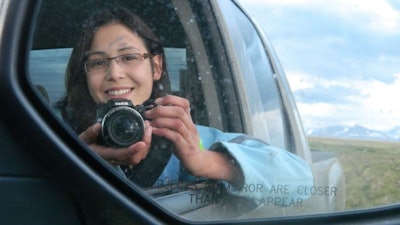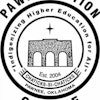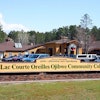 Ashley Loring Heavyrunner
Ashley Loring Heavyrunner
That’s why, when one of them goes missing or is murdered, the impact ripples across communities, tribes, and nations.
And for Native Americans, those missing and murdered aren't just an unlucky few. There are thousands of indigenous people who have vanished without a trace, or have been found murdered, and their attacker has never been brought to justice.
Real data on the full figure and impact of Missing and Murdered Indigenous Persons (MMIPs) is severely limited. But experts note that four in five Native American women have experienced violence, and more than half have experienced sexual violence, according to the Indian Law Resource Center. Men and non-binary individuals are also attacked at a higher rate than any other racial group in the U.S., and most of the violence perpetrated against Native people comes from non-indigenous persons, with four out of five assaults perpetrated by a white person. Additionally, about 75% of the deaths of indigenous youths aged 12 to 20 are caused by violence. One third of indigenous women will be raped in their lifetime, and three out of four will be physically assaulted. Non-binary or two-spirit people (those persons who ascribe to a third gender) have a 66% chance of being sexually assaulted in their lifetime.
 Cheryl Crazy Bull
Cheryl Crazy Bull
Tribal Colleges and Universities (TCUs) are often the central hub for their communities, working to preserve language, culture, and sovereignty for tribal nations. But their educational walls alone cannot stop violence from impacting their faculty, staff, or students.
In June 2017, 20-year-old Blackfeet Community College (BCC) student Ashley Loring Heavyrunner disappeared. Four years later, investigators are still no closer to solving her case.
Heavyrunner’s case has reappeared in headlines in the wake of the murder of Gabby Petito, a white woman who vanished on her trip across the country with her fiancé, Brian Laundrie. Petito’s story gathered a swarm of media, and her body was found eight days after she was reported missing.
There is a saying in Indian Country that, when a woman goes missing, she disappears twice; the first time her body disappears; the second time, her story disappears.
As often happens for the missing and murdered indigenous women (MMIW), it falls to those who knew and loved them, often living on reservations with few resources, to try and scrape together some form of justice. At Blackfeet Community College, students have come together to create a database for missing persons. At the Institute of American Indian Arts (IAIA) in New Mexico, students pour their grief and outrage into art. TCUs have become the loci of action, working to address the grief that has touched so many lives.
David Bledsoe, senior manager of engagement and communications at The American Indian College Fund, said the impact of MMIP corresponds with Maslow’s hierarchy of needs, the pyramid theory that personal success can only be achieved when basic needs like food, housing, and safety and security are met.
“Students are seeking a higher education degree, and [they’re] literally living in a community where people are disappearing and there are no investigations,” said Bledsoe. “That’s a huge obstacle, for you to have a normal life and seek other priorities or what you want for yourself and your community, when people go missing. One of the biggest obstacles is because that safety isn’t there.”
Crazy Bull knows the reality of her community can be hard to imagine for those that haven’t lived it.
 A red handprint, the symbol for MMIP
A red handprint, the symbol for MMIP
“We often talk about how to help others understand the communities we come from, which are heartbroken and devastated by government policies that don’t invest enough resources,” said Crazy Bull. “It’s almost one of those environments that… it’s just part of your journey, as a person, as a family, as a community. I don’t know that you could ever completely heal communities.”
But whatever healing can be done, she said that TCUs are dedicated to the mission.
“TCUs are bringing students access to mental health resources rooted in tribal knowledge, which could be ceremonies, song and drumming together, different kinds of prayer opportunities, reinforcing memorial practices,” said Crazy Bull. “They’re providing students, faculty, and staff access to mental health counseling.”
“It’s one of the reasons we believe in education, because it gives people hope when they may feel like, it’s so hard here, with violence or with suicides or with the lack of resources,” said Crazy Bull. “But education, you can turn to it, and it will give you a different path.”
She said that TCUs are able to provide mechanisms and access to resources that enables the communities so impacted by loss to take more measures to educate and help themselves.
At BCC, Drew Landry, who was a student at the time Heavyrunner went missing, helped Ashley’s sister Kimberly Loring organize a petition for justice. Through their work, they were able to gather 55,000 signatures. The petition called attention to the lack of resources applied to Heavyrunner’s case, and Landry said he’s already seen progress.
“There’s been a lot more resources available to handle these types of cases,” said Landry. “We see a budget in law enforcement but also cooperation between the federal, state, and tribal law enforcement.”
Landry, who now works as the USDA Extension Agent at BCC, credits progress on the case to Loring’s tenacity and tireless pursuit of justice.
“[Kimberley’s] work, not giving up on her case, inspired hundreds if not thousands of other folks to continue looking,” said Landry. “A lot of people here have given up on justice. They won’t even call the cops. [Kimberly] helped this become national. Other people that saw her not give up, it inspired them to fight harder and not take no for an answer.”
Landry and Loring’s work behind the scenes helped BCC get a grant from the Department of Justice. A matching grant from AT&T has allowed for the creation of a portable database that coaches users through the process of filing a missing person’s report. Landry made sure that his website could be used on cell phones, as many rural indigenous populations don’t have computers but rely on smart phones instead. Landry is also training a group of liaisons within each community to be the go between from tribal nation to law enforcement.
When families missing an individual use the web portal to report a missing person, it creates a carbon copy that’s sent not only to police dispatch but to Landry. He can contact the families, make sure they take the proper next steps to try and find their missing person, and can then follow up with the police to see the progress being made.
Landry said this developing system at BCC isn’t just a way to track missing persons. It connects families to each other, bringing them the support of a community and the resources provided by the college.
If the soft launch of the database in 2022 goes well, Landry and his team at BCC hope to take the program to the whole state of Montana, where an indigenous person is four times as likely to go missing than anywhere else in the U.S. If Montana is a success, then the system will be rolled out nationwide.
 Winning design by Little Big Horn College student Deshawna Anderson for Pendleton and The American Indian College Fund competition pays homage to the lost MMIP
Winning design by Little Big Horn College student Deshawna Anderson for Pendleton and The American Indian College Fund competition pays homage to the lost MMIP
In New Mexico, a state with one of the highest rates of human trafficking, IAIA helps its students and faculty cope with MMIP through their art. Newton Onco said his time at IAIA as a student, has helped him to understand the scope of the crisis and pushed his need to make something creative to help the cause of so many. Onco has written a song about MMIW to heal, to inspire, and to raise awareness. He’ll finish recording at the end of October, and he has plans to film a music video in November.
Onco grew up in Oklahoma. In high school, he became friends with a woman named Angela “Sam” Maynahonah Rodriguez. Her body was found on March 29, 2012, 65 miles from where she lived. She had been murdered. Her case remains unsolved.
Onco is full of ideas about how he wants the story to look on screen: Native women, in their traditional clothing, standing with their arms raised, chanting, their mouths painted over by a blood-red handprint, a symbol for MMIP across the nations. Red, some Native cultures believe, is the only color that spirits can see. Together, they sing his chorus:
“MMIW, Sisters! We sure miss you. MMIW, Sisters! We’re going to find you. We sit around and we wonder why, as we look into the sky, I hear your voices in the blowing winds, remembering smiles that never end. We’re going to find you.”
Liann Herder can be reached at [email protected].
















